
The Lincoln Memorial is a U.S. national memorial that honors the 16th president of the United States, Abraham Lincoln. An example of neoclassicism, it is in the form of a classical temple and is located at the western end of the National Mall in Washington, D.C. Henry Bacon is the memorial's architect and Daniel Chester French designed the large interior statue of a seated Abraham Lincoln (1920), which was carved in marble by the Piccirilli brothers. Jules Guerin painted the interior murals, and the epitaph above the statue was written by Royal Cortissoz. Dedicated on May 30, 1922, it is one of several memorials built to honor an American president. It has been a major tourist attraction since its opening, and over the years, has occasionally been used as a symbolic center focused on race relations and civil rights.

Lee Oscar Lawrie was an American architectural sculptor and an important figure in the American sculpture scene preceding World War II. Over his long career of more than 300 commissions Lawrie's style evolved through Modern Gothic, to Beaux-Arts, Classicism, and, finally, into Moderne or Art Deco.

Daniel Chester French was an American sculptor of the late nineteenth and early twentieth centuries. He is best known for his 1874 sculpture The Minute Man in Concord, Massachusetts, and his 1920 monumental statue of Abraham Lincoln in the Lincoln Memorial in Washington, D.C.
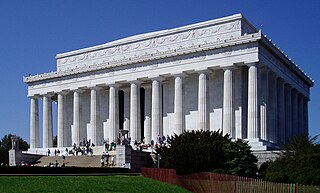
Henry Bacon was an American Beaux-Arts architect who oversaw the engineering and design of the Lincoln Memorial in Washington, D.C., built between 1915 and 1922, which was his final project before his 1924 death.
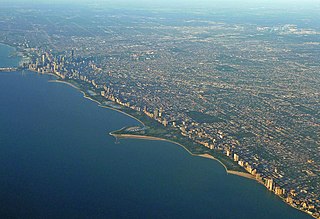
Lincoln Park is a 1,208-acre (489-hectare) park along Lake Michigan on the North Side of Chicago, Illinois. Named after US President Abraham Lincoln, it is the city's largest public park and stretches for seven miles (11 km) from Grand Avenue, on the south, to near Ardmore Avenue on the north, just north of the DuSable Lake Shore Drive terminus at Hollywood Avenue. Two museums and a zoo are located in the oldest part of the park between North Avenue and Diversey Parkway in the eponymous neighborhood. Further to the north, the park is characterized by parkland, beaches, recreational areas, nature reserves, and harbors. To the south, there is a more narrow strip of beaches east of Lake Shore Drive, almost to downtown. With 20 million visitors per year, Lincoln Park is the second-most-visited city park in the United States, behind Central Park.

Adolph Alexander Weinman was a German-born American sculptor and architectural sculptor.

Albert Square is a public square in the centre of Manchester, England. It is dominated by its largest building, the Grade I listed Manchester Town Hall, a Victorian Gothic building by Alfred Waterhouse. Other smaller buildings from the same period surround it, many of which are listed.
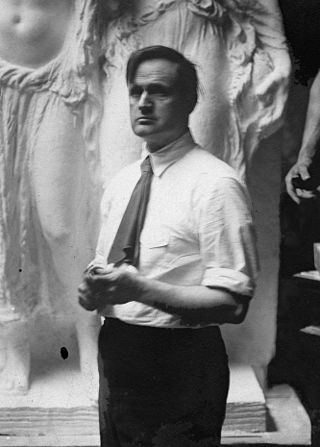
James Earle Fraser was an American sculptor during the first half of the 20th century. His work is integral to many of Washington, D.C.'s most iconic structures.

The Chicago Cultural Center, opened in 1897, is a Chicago Landmark building operated by Chicago's Department of Cultural Affairs and Special Events. The Cultural Center houses the city's official reception venue, where the Mayor of Chicago has welcomed presidents, royalty, diplomats, and community leaders. It is located in the Loop, across Michigan Avenue from Millennium Park.

George Rogers Clark National Historical Park, located in Vincennes, Indiana, on the banks of the Wabash River at what is believed to be the site of Fort Sackville, is a United States National Historical Park. President Calvin Coolidge authorized a classical memorial and President Franklin D. Roosevelt dedicated the completed structure in 1936.

The Thomas Jefferson Building, also known as the Main Library, is the oldest of the Library of Congress buildings in Washington, D.C. Built between 1890 and 1897, it was initially known as the Library of Congress Building. In 1980, the building was named in honor of Thomas Jefferson, a Founding Father, the principal author of the Declaration of Independence, and the third U.S. president. In 1815, Jefferson's donation of his own book collection formed a core foundation for the library's collection.

541 North Fairbanks Court, formerly the Time-Life Building, is a 404-foot-tall (123 m), 30-story skyscraper in Chicago, Illinois, designed by Harry Weese and completed in 1969. Located on the Near North Side, it was among the first in the U.S. to use double-deck elevators. The odd-numbered floors are accessible from the lower lobby, with even floors serviced from the upper level.
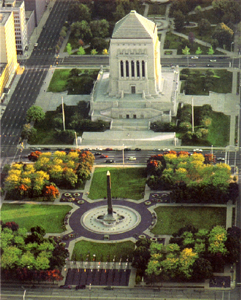
The Indiana World War Memorial Plaza is an urban feature and war memorial located in downtown Indianapolis, Indiana, United States, originally built to honor the veterans of World War I. It was conceived in 1919 as a location for the national headquarters of the American Legion and a memorial to the state's and nation's veterans.

Abraham Lincoln: The Man is a larger-than-life size 12-foot (3.7 m) bronze statue of Abraham Lincoln, the 16th president of the United States. The original statue is in Lincoln Park in Chicago, and later re-castings of the statue have been given as diplomatic gifts from the United States to the United Kingdom, and to Mexico.
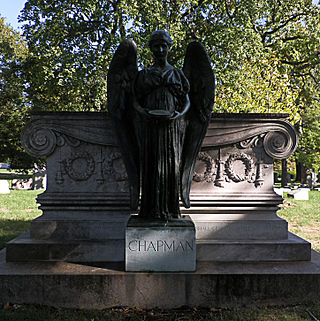
T.A. Chapman Memorial is a public artwork by American artist Daniel Chester French. It is located at 2405 W. Forest Home Ave., in the Forest Home Cemetery Section 33 in Milwaukee, Wisconsin, United States. The bronze sculpture was cast in 1896. Its dimensions are 62 x 41 x 23 in. The concrete base it stands on is 13 ½ x 21 7/8 x 14 3/8 in.

Eric Gugler was an American Neoclassical architect, interior designer, sculptor and muralist. He was selected by President Franklin D. Roosevelt to design the Oval Office.

The Minnesota State Capitol Mall includes eighteen acres of green space. Over the years, monuments, and memorials, have been added to the mall. The mall has been called Minnesota's Front lawn and is a place where the public has gathered for celebrations, to party, to demonstrate and protest, and to grieve.

















